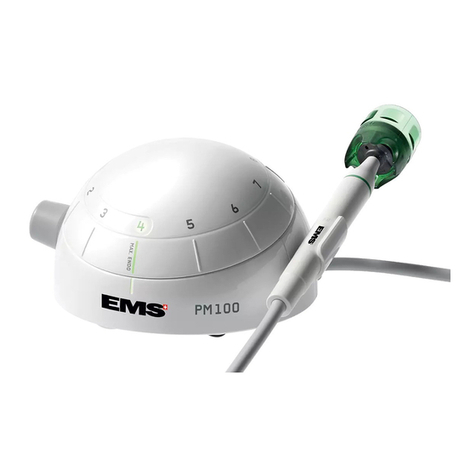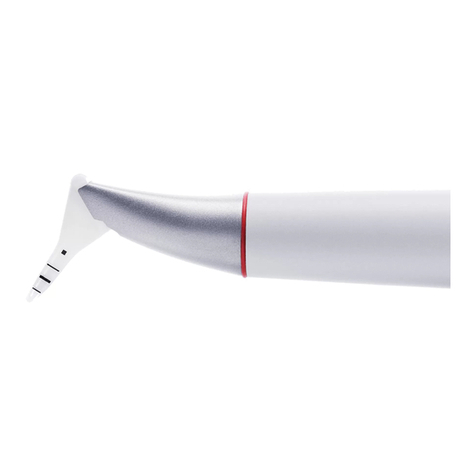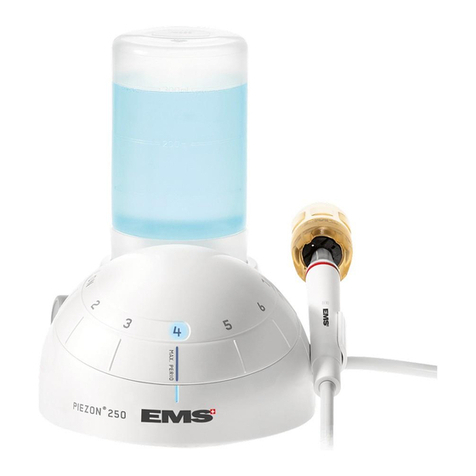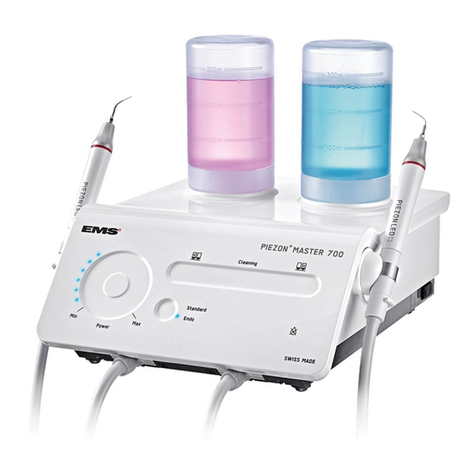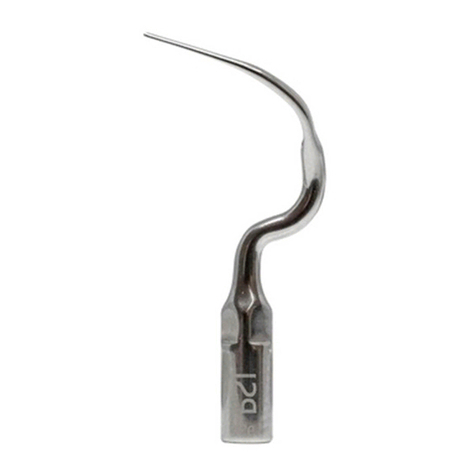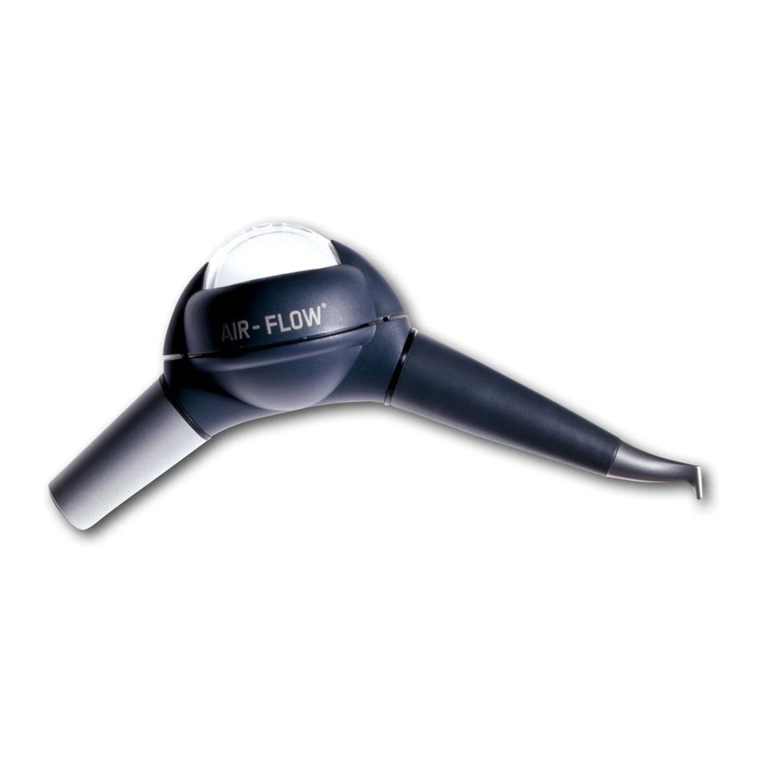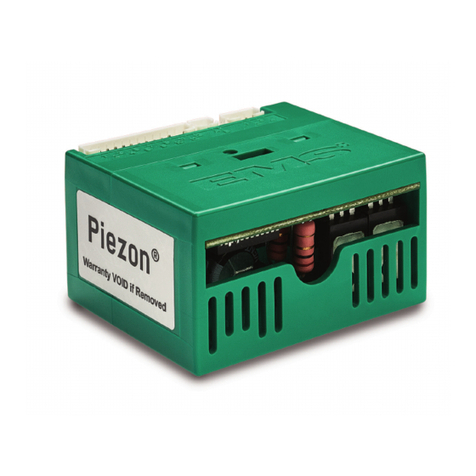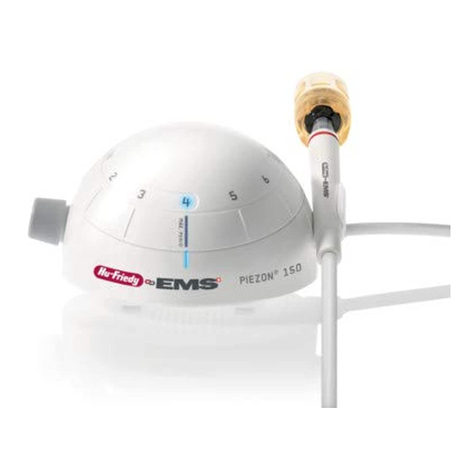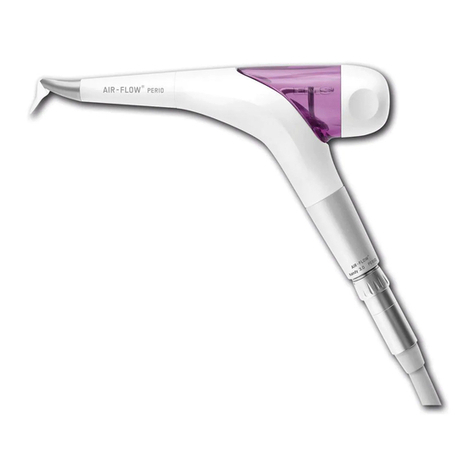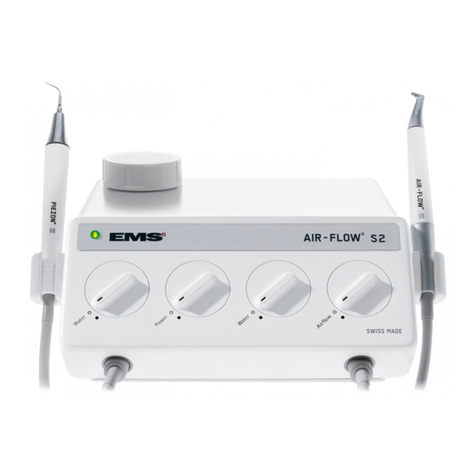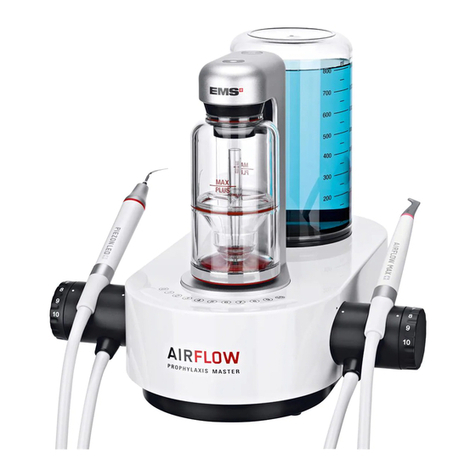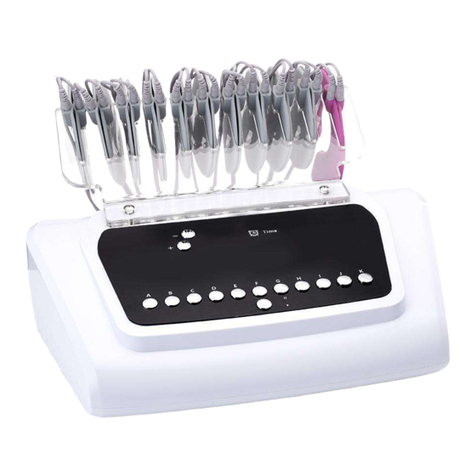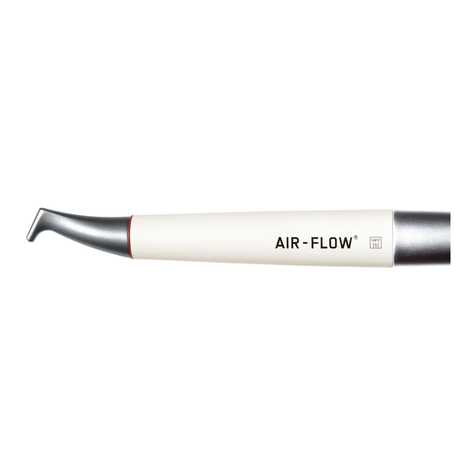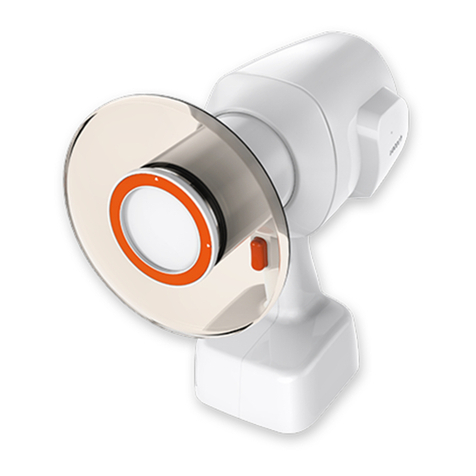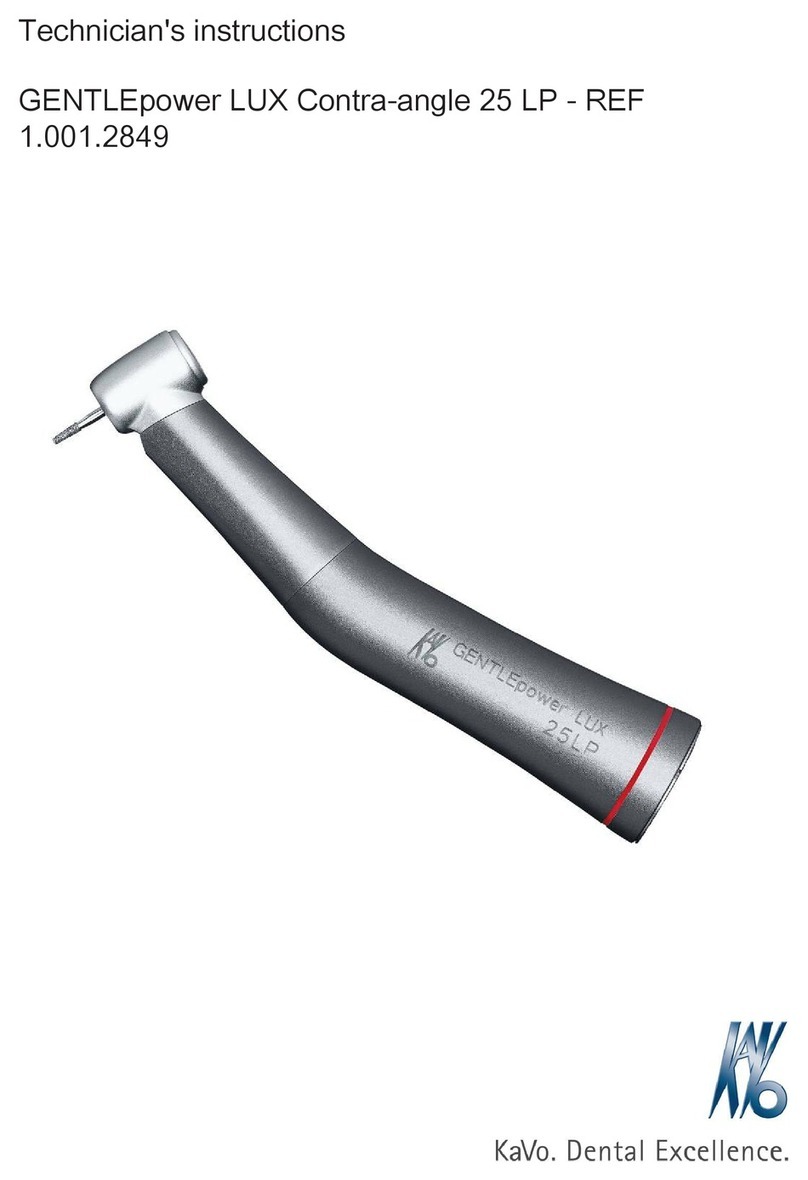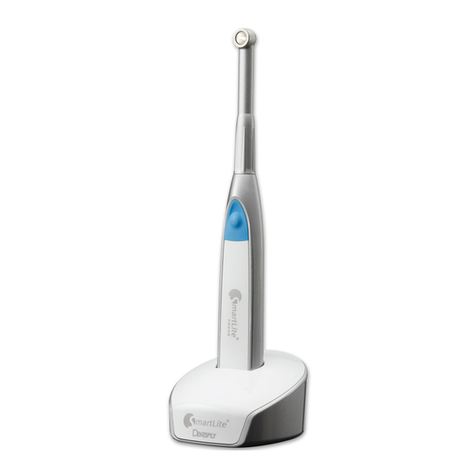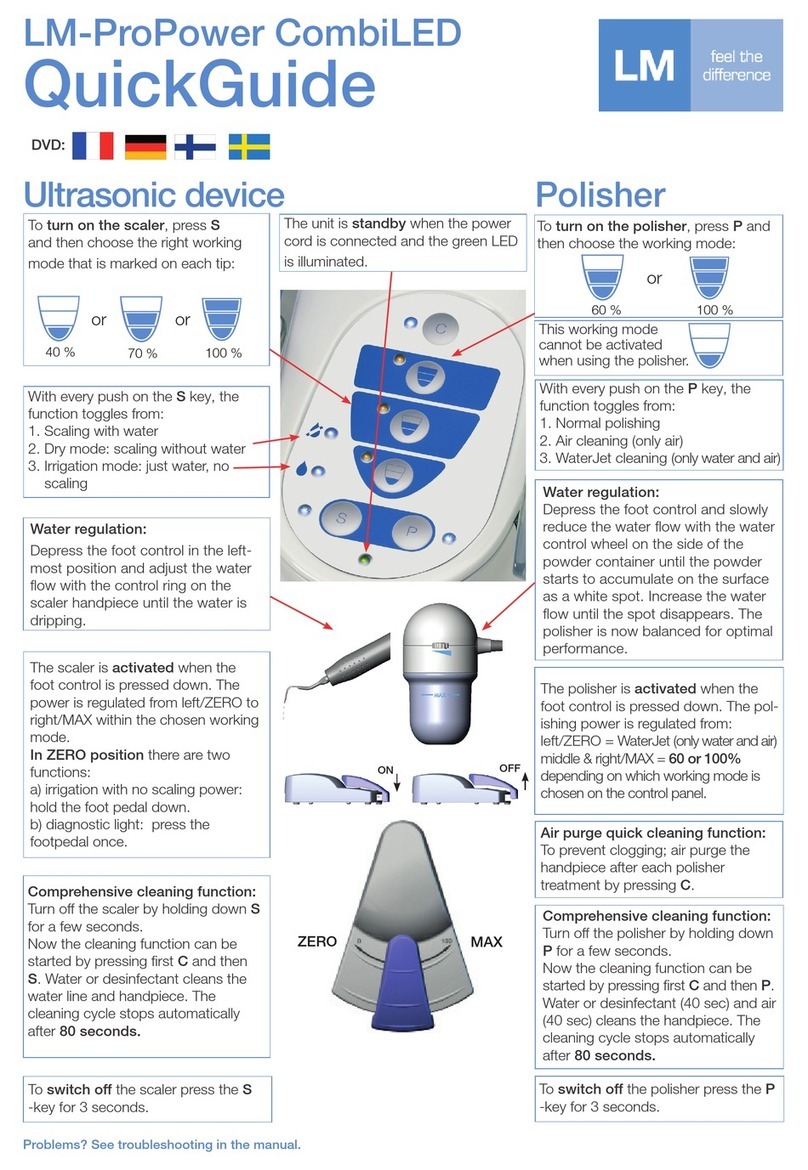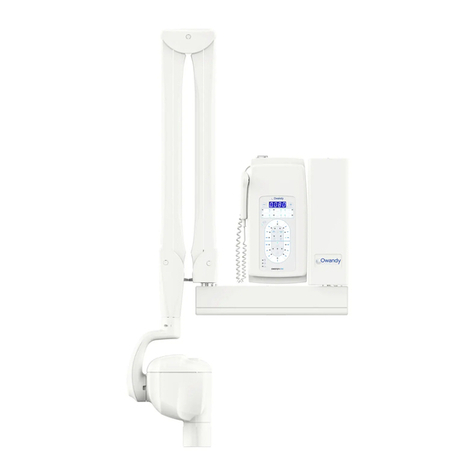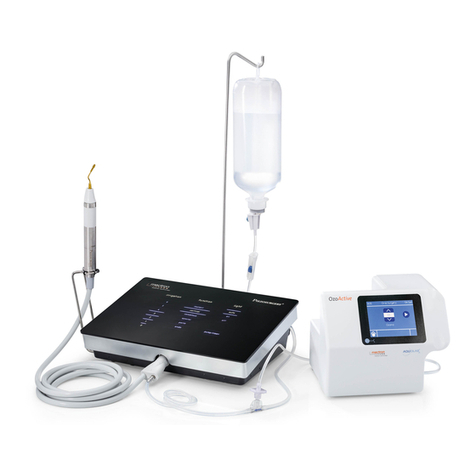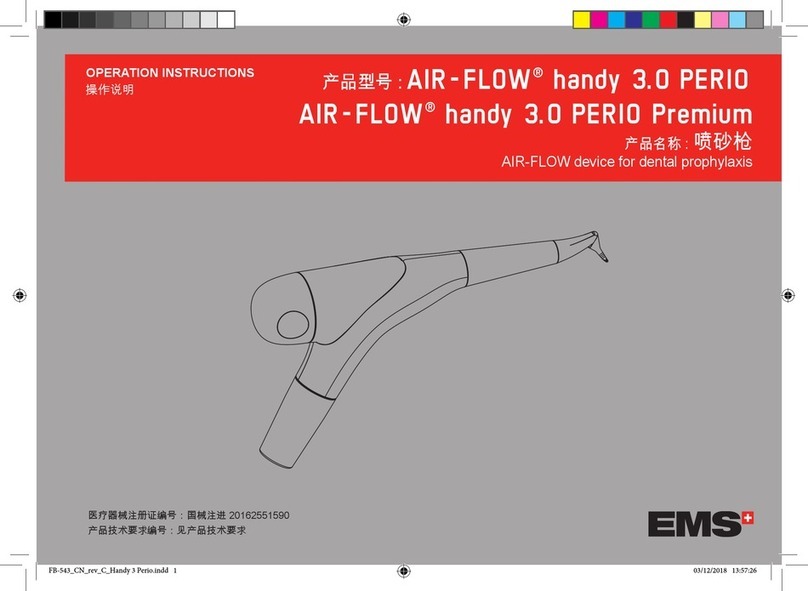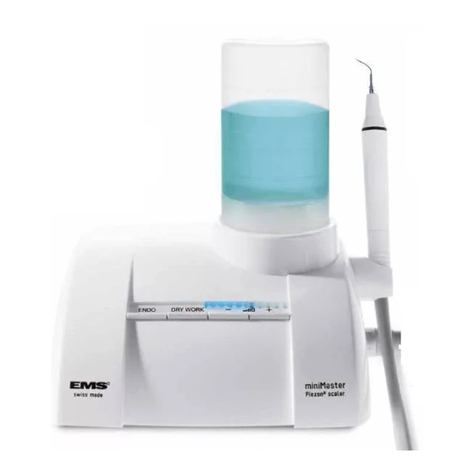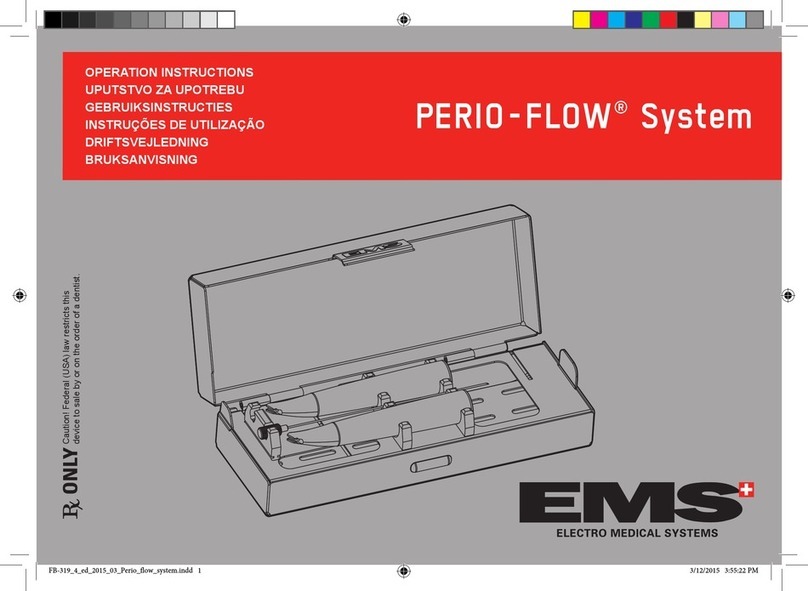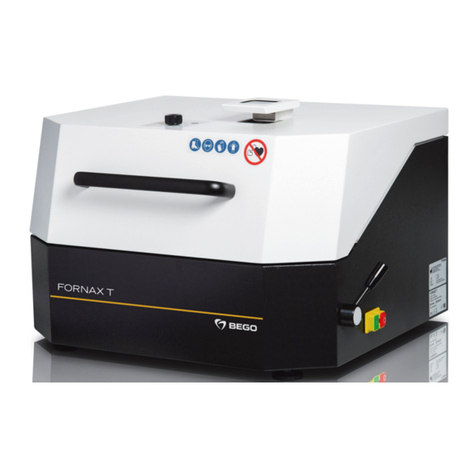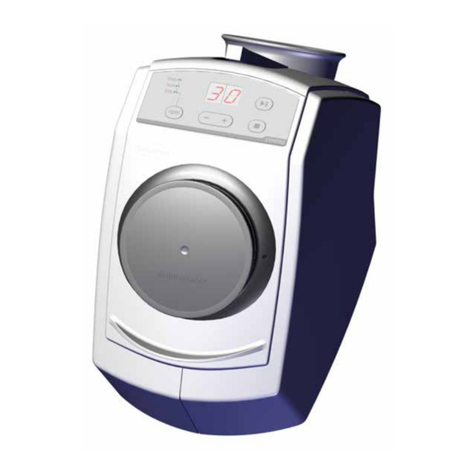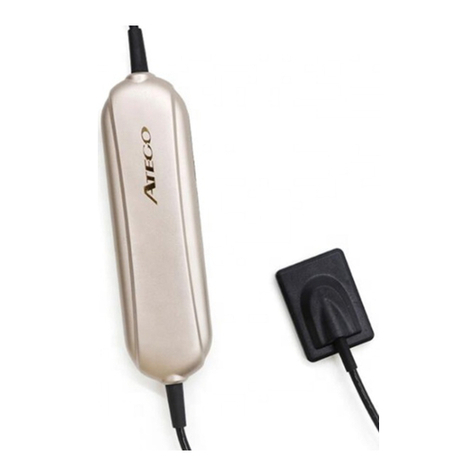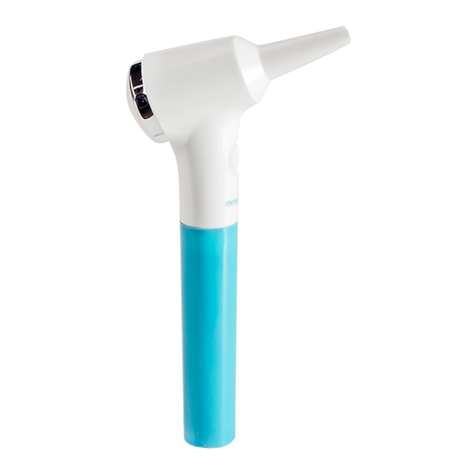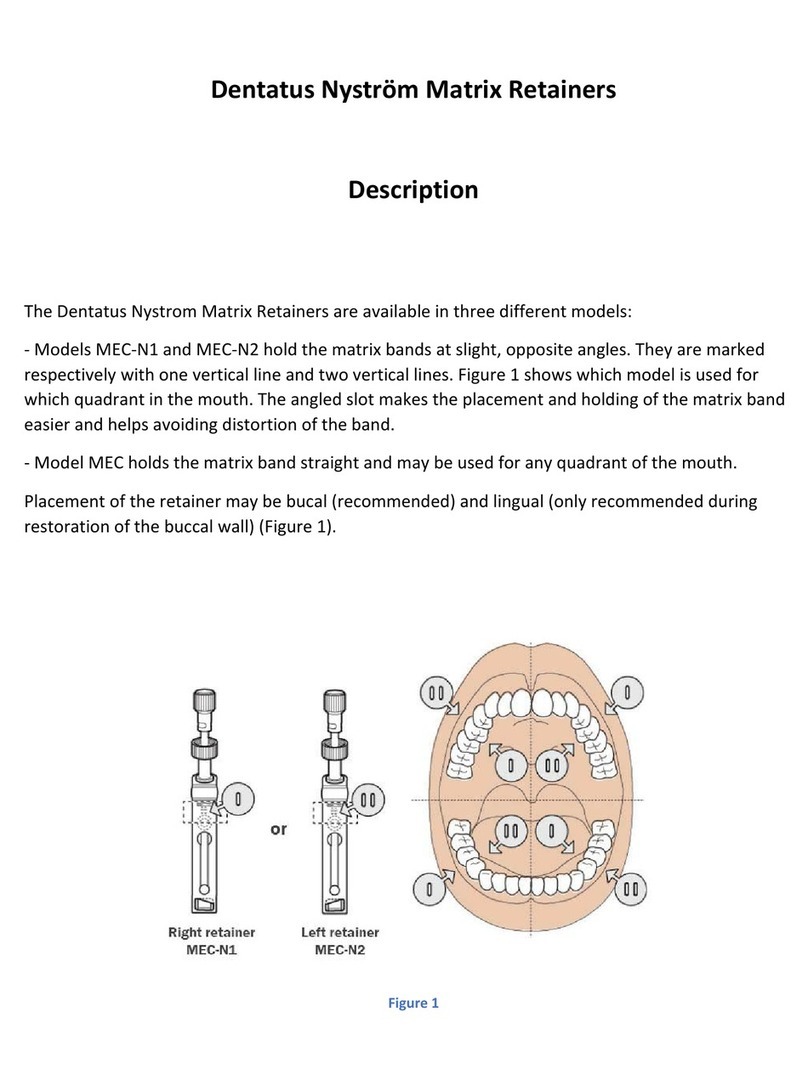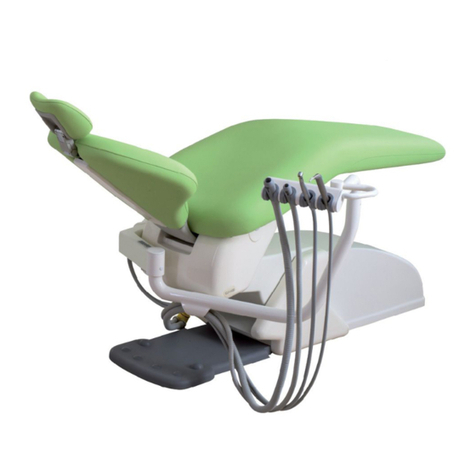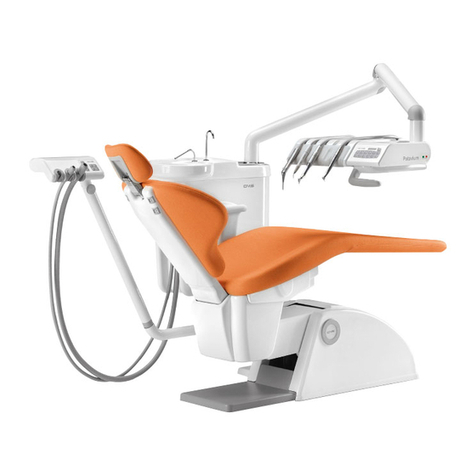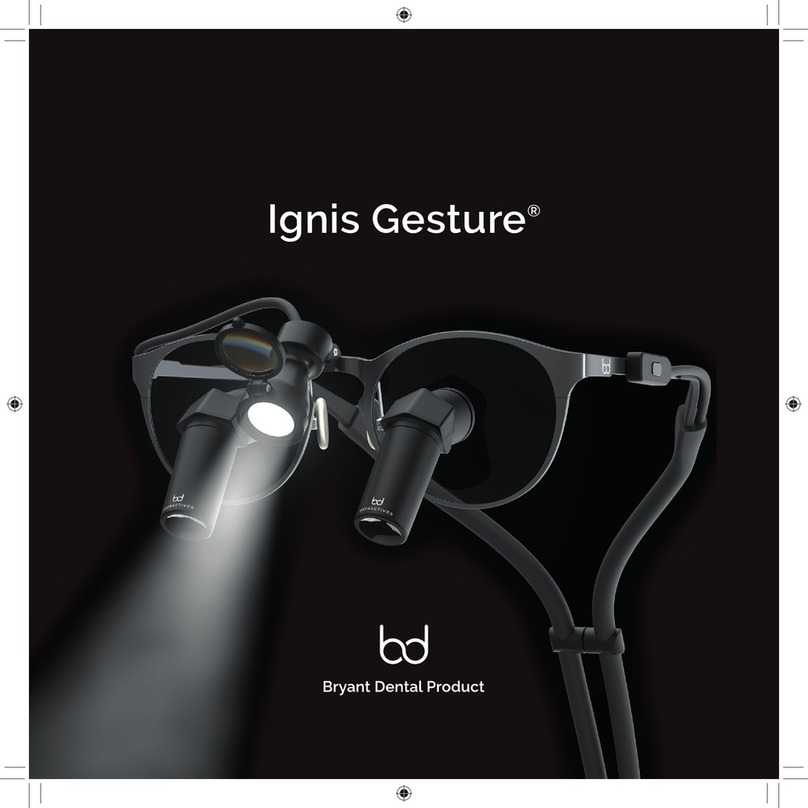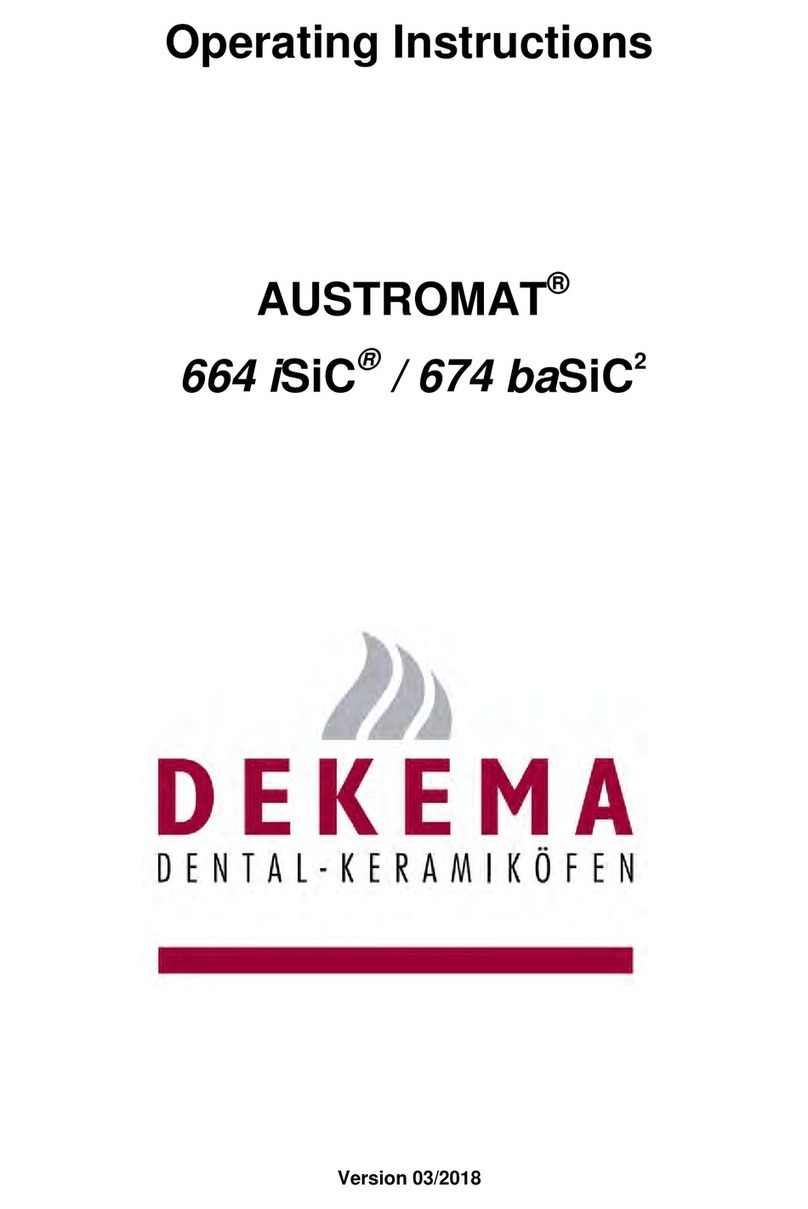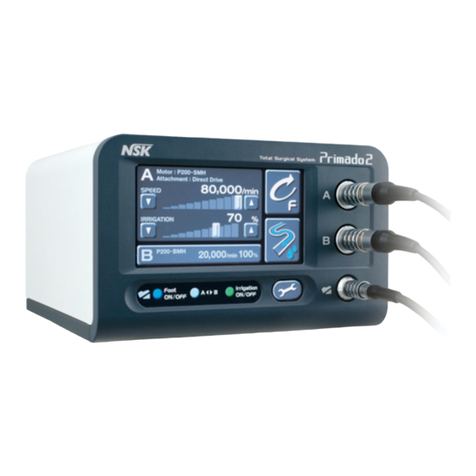
4 5
PATIENT POPULATION
AIRFLOW®devices are intended for use on patients requiring dental treatment, including cleaning and polishing of teeth (natural
or implant) by the projection of water, air and dental powders onto the tooth surface, regardless of age or gender.
This medical device is not intended for use on newborn (neonate) and infant (< 2 years old) patient populations.
INTENDED ENVIRONMENT
The device is intended to be used in a dental cabinet/hospital complying with each country’s regulations.
CONTRAINDICATIONS
AIRFLOW®
Patients suffering from chronic bronchitis or asthma must not, under any circumstances, be treated with an air polishing
device. The jet of air and powder could cause respiratory difficulties.
Patients on a low salt diet must not be treated with the powder containing sodium bicarbonate. For patients on a law salt
diet use the powder without sodium bicarbonate provided by EMS.
PERIOFLOW®
The treatment of deep periodontal pockets can cause bacteraemia. Please apply appropriate restrictions for the treatment of
risk patients:
Endocarditis
Pregnancy, breast feeding
Contagious disease
Immune deficiency (neutropenia, angranulocytosis, diabetes, hemophilia)
Patients under treatment (radiotherapy, chemotherapy, antibiotics)
The air jet and powder may cause breathing difficulties. Please apply appropriate restrictions for the treatment of risk
patients: Patients suffering from chronic bronchitis or asthma must not be treated under any circumstances with this product.
Predisposed persons may be sensitive to the powder. If allergic reactions are observed, stop using the product and
completely remove it.
The single use nozzle must be used for one single patient only. Never reuse a nozzle because treatment will be ineffective
and the risk of emphysema would increase.
The use of any other powder than the EMS powders for subgingival application would reduce the nozzle's service life. As a
result the treatment would become ineffective and would increase the risk of emphysema.
Powders
Refer to the instructions for use of the specific powder.
COMPATIBILITY
This device is compatible with the following accessories:
AIRFLOW®Powders DV-164, DV-165 series
AIRFLOW®MAX Handpiece E L- 3 0 8
PERIOFLOW®Handpiece E L- 3 5 4
AIRFLOW STATION / STATION+ DW-048A, DW-048B
Applied Parts
The following items are Medical Device Applied Parts:
AIRFLOW®MAX (EL-308) Handpiece
PERIOFLOW®(EL-354) Handpiece
Applied Parts, under certain operating conditions, may exceed 41°C of temperature and reach a maximum temperature of
51°C.
GENERAL PRECAUTIONS
ONLY USE EMS ACCESSORIES AND CONSUMABLES!
The use of any other accessories could lead to patient injury, malfunction or damage to the device.
DO NOT use this device in the presence of flammable anesthetics or oxidizing gases (such as nitrous oxide (N2O) and
oxygen) or in close proximity to volatile solvents (such as ether or alcohol), as explosion may occur.
DO NOT store the powder near acids or heat sources.
TAKE the following precautions to prevent any adverse events to the patient and/or to the user in case of electromagnetic
disturbances:
Always refer to the information listed in the chapter “Electromagnetic Compatibility”.
BEFORE USE
CONGRATUL ATIONS!
You are now the owner of this new EMS device!
Please read the instructions carefully before use.
TO AVOID the risk of electric shock, this equipment must
only be connected to a mains supply with protective earth/
grounding. This device uses a Class-I insulating system that
requires protective earth.
FOR USA AND CANADA: GROUNDING RELIABILITY CAN ONLY
BE ACHIEVED WHEN EQUIPMENT IS CONNECTED TO AN
EQUIVALENT RECEPTACLE MARKED “HOSPITAL ONLY” OR
“HOSPITAL GRADE”.
DO NOT modify this equipment and/or any of its
accessories.
No modification of any part of this medical device is allowed.
DO NOT open the device. There are no serviceable parts
inside.
If any serious incident occurs that is directly or indirectly
related to the device, report it immediately to the manufacturer
and to the competent authority of your country and of where
the patient is established (if different).
Disconnect the mains plug from electrical outlet for the
purposes of maintenance, in the case of malfunction or when
the device is left unattended.
Turn off the water inlet when not in use. The device is
not equipped with Aquastop and the EG-110 water hose may
disconnect or leak: risk of flooding.
The Instructions for Use of the device, as well as
the Treatment Recommendations (FB-648), are provided in
electronic format and are part of the product documentation.
However, if you would like to receive these in hard copy, you can
request one set free of charge on our website, by telephone or
in writing, and receive it within 7 days.
The Instructions for Use of the device (FB-621), as well as
the Treatment Recommendations (FB-648), are available for
download in PDF format at www.ems-instruction.com using
the Product/Key Code FT-230. A PDF reader is required and,
in case of need, it can be downloaded from the same web site.
It is essential to first read and understand all the Instructions
for Use of the device before operating it and using the related
accessories. The Treatment Recommendations are an
integral part of the device’s Instruction for Use and each one
document is complementary to the other. Always keep this
documentation close at hand.
We recommend that you visit our website regularly to consult
and/or download the latest version of the documentation for
your device at www.ems-instruction.com
Please contact EMS technical support or your local EMS
representative for further information and support.
INTENDED USE
The AIRFLOW One is intended for use in the cleaning and polishing of teeth by the projection of water, air, and dental powders
onto the tooth surface. The device removes dental plaque, soft deposits, and surface stains from pits, grooves, interproximal
spaces, or smooth surfaces of teeth.
The AIRFLOW One can be used for the following cleaning procedures:
plaque removal for placement of sealants
surface preparation prior to bonding/cementation of inlays, onlays, crowns and veneers
surface preparation prior to placing composite restorations
effective plaque and stain removal for orthodontic patients
cleaning prior to bonding ortho brackets
cleaning implant fixture prior to loading
stain removal for shade determination
plaque removal prior to fluoride treatment
plaque and stain removal prior to whitening procedure
The AIRFLOW One is also intended for use as an air-polisher in patients suffering from periodontal disease. The AIRFLOW
Prophylaxis Master is indicated for the non-surgical removal of subgingival plaque in pockets up to 5 mm after initial periodontal
treatment.
INTENDED USERS
Only qualified dental professionals must use this device by fully complying with their respective country’s regulations, accident
prevention measures, and strictly follow these instructions for use.
The device must be prepared and maintained only by persons who have been instructed in infection control, personal
protection and patient safety.
Improper use (e.g. due to lack of hygiene or routine maintenance), non-compliance with our instructions, or the use of
accessories and spare parts that are not approved by EMS invalidates all claims under warranty and any other claims.
No specific training other than initial professional training is required to use this medical device.
The practitioner is responsible for performing the clinical treatments and for any dangers that may arise due to a lack of skill
and/or training.
For optimal patient comfort, safety and efficiency, we suggest that you regularly follow our: SWISS DENTAL ACADEMY Training
Program. Please contact your local EMS representative for further information.
Professional product installation and product introduction by EMS certified person is highly recommended for optimal setup
and reliability.
